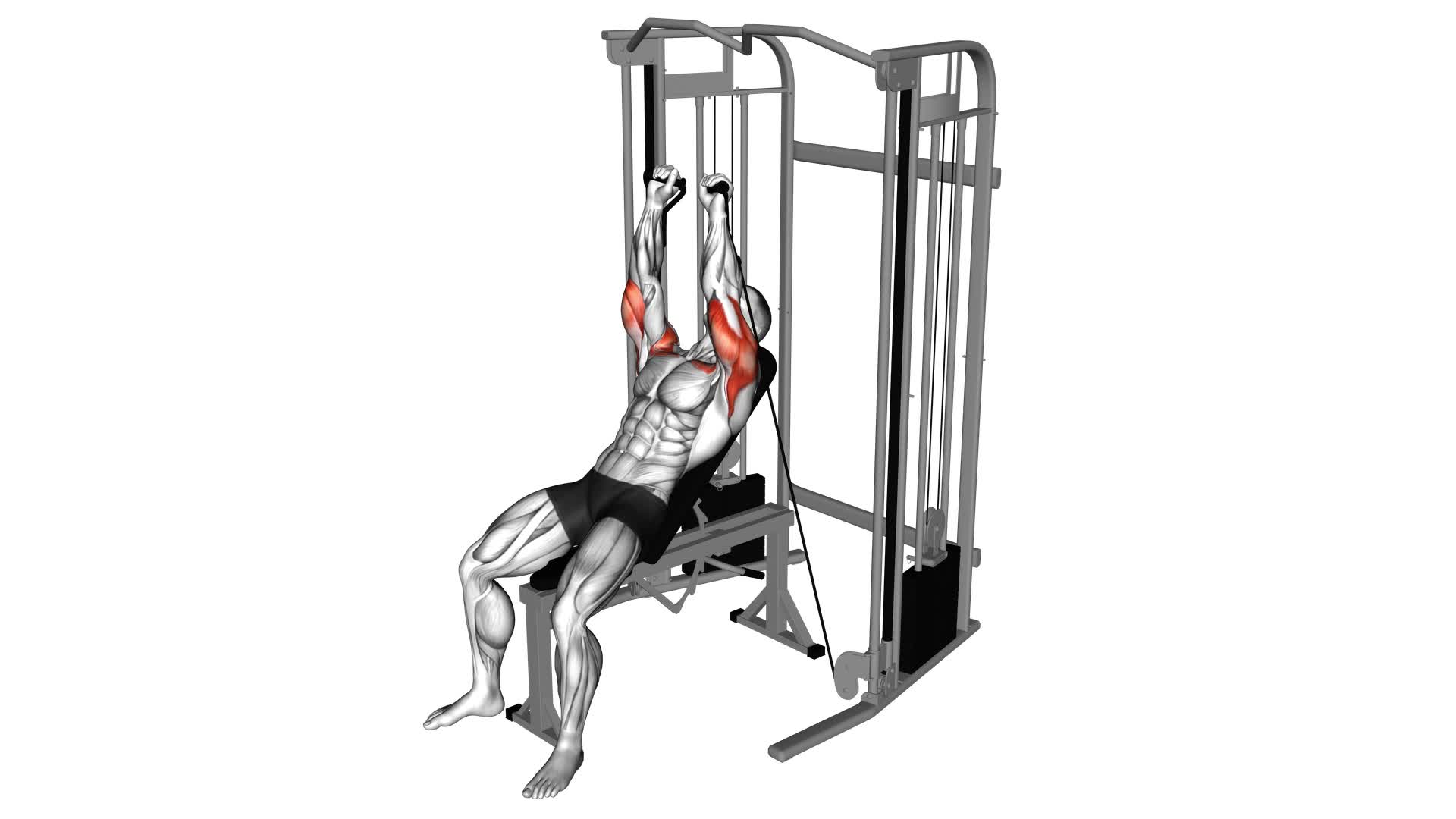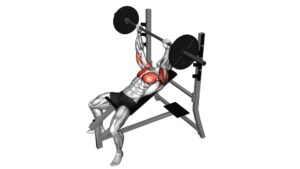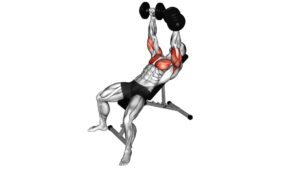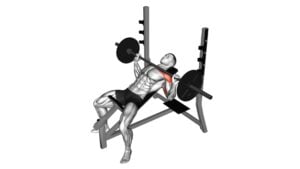Cable Incline Bench Press – Video Exercise Guide & Tips

Looking to take your upper body workout to the next level? The Cable Incline Bench Press is a great exercise for targeting your chest, shoulders, and triceps.
Watch This Exercise Video
In this video exercise guide, we'll show you the proper setup, technique, and common mistakes to avoid.
Plus, we'll share tips for increasing intensity and progressing in your workouts.
Get ready to sculpt and strengthen your upper body with this effective exercise.
Let's get started!
Key Takeaways
- Cable incline bench press targets multiple muscle groups simultaneously
- Proper setup and equipment are essential for safe and effective performance
- Engaging the core and maintaining proper form is crucial to avoid injury
- Gradually increasing intensity and incorporating muscle activation strategies can lead to maximum gains.
Benefits of Cable Incline Bench Press
Boost your upper body strength and muscle gains with the Cable Incline Bench Press. This exercise offers a range of benefits that can enhance your overall fitness routine. One of the main advantages of the Cable Incline Bench Press is its ability to target multiple muscle groups simultaneously. By adjusting the incline of the bench, you can focus on different areas of your chest, shoulders, and triceps. This exercise also engages your core muscles, helping to improve stability and balance. Additionally, the cable resistance provides constant tension throughout the movement, which can lead to increased muscle activation and growth.
Another benefit of the Cable Incline Bench Press is its versatility. There are several variations of this exercise that you can incorporate into your workout routine. For example, you can use different grip positions, such as a neutral grip or a wide grip, to target specific muscles in your upper body. You can also perform the exercise unilaterally, using one arm at a time, to further challenge your stability and coordination.
Proper Setup and Equipment for Cable Incline Bench Press
To properly set up and perform the Cable Incline Bench Press, you'll need the appropriate equipment and ensure a correct positioning on the bench. Here are the necessary steps to get ready for the exercise:
- Adjust the cable machine: Set the pulley system to its lowest position and attach the appropriate handles or attachments.
- Position the bench: Place an incline bench in front of the cable machine and adjust it to your desired angle. Ensure that the bench is stable and secure.
- Attach the cables: Connect the handles or attachments to the cables, making sure they're secure and won't come off during the exercise.
Having the proper setup and equipment is crucial for performing the Cable Incline Bench Press safely and effectively. The correct positioning on the bench ensures that your body is supported and stable throughout the exercise.
Now that you have everything set up, let's move on to the step-by-step guide to performing the Cable Incline Bench Press.
Step-by-Step Guide to Performing Cable Incline Bench Press
To perform the Cable Incline Bench Press, follow these step-by-step instructions for a safe and effective workout.
- Start by adjusting the incline bench to a 45-degree angle. Make sure the bench is stable and secure before proceeding.
- Next, attach the cable handles to the pulley system at a height slightly above shoulder level. Stand facing away from the machine and grasp the handles with an overhand grip.
- Step forward, keeping your feet shoulder-width apart, until you feel tension in the cables. This is your starting position.
- With your core engaged and your back flat against the bench, slowly lower the handles towards your chest, keeping your elbows at a 90-degree angle.
- Pause for a moment, then push the handles back up to the starting position, fully extending your arms. Repeat for the desired number of repetitions.
When performing the Cable Incline Bench Press, there are variations you can incorporate to target different muscle groups.
- For example, you can use a close grip or a wide grip to emphasize different areas of the chest.
- Additionally, adjusting the incline angle can further target specific muscles.
The Cable Incline Bench Press offers several benefits compared to the flat bench press.
- It places more emphasis on the upper chest and shoulders, helping to develop a well-rounded and proportionate upper body.
- It also requires greater stabilization, engaging more muscles throughout the exercise.
Incorporating the Cable Incline Bench Press into your routine can help you achieve better overall strength and muscle development.
Common Mistakes to Avoid During Cable Incline Bench Press
When performing the Cable Incline Bench Press, it's important to be aware of common mistakes that can hinder your progress and potentially lead to injury. To ensure you get the most out of this exercise and maintain proper form, here are some key tips to keep in mind:
- Avoid using excessive weight: Using too much weight can compromise your form and increase the risk of injury. Start with a weight that allows you to perform the exercise with proper technique and gradually increase as you become more comfortable.
- Maintain a stable core: It's crucial to engage your core muscles throughout the movement to stabilize your body and prevent any excessive arching or rounding of the back. This will help protect your spine and maximize the effectiveness of the exercise.
- Control the movement: One common mistake is using momentum to lift the weight instead of relying on your muscles. It's important to control the weight throughout the entire range of motion, both on the way up and down, to fully engage your chest muscles and avoid any unnecessary strain.
Tips for Increasing Intensity and Progressing in Cable Incline Bench Press
To increase intensity and progress in the Cable Incline Bench Press, focus on gradually increasing the weight and challenging your muscles with each workout. One of the most effective progression techniques is called progressive overload. This involves gradually increasing the amount of weight you lift over time. Start with a weight that allows you to perform the exercise with proper form, and then gradually increase the weight as you become stronger. Aim to add a small amount of weight each week or every other week to keep challenging your muscles.
Another progression technique is to vary the tempo of your repetitions. By slowing down the lowering phase of the exercise (eccentric phase), you can increase the time your muscles are under tension, leading to greater muscle activation and growth. Additionally, you can incorporate muscle activation strategies such as squeezing your chest muscles at the top of the movement and focusing on maintaining tension throughout the exercise. This will help you engage your chest muscles more effectively and maximize your gains.
Remember to always listen to your body and adjust the weight and intensity based on your individual capabilities. It's important to challenge yourself, but also to prioritize proper form and technique to prevent injuries. With consistent effort and a focus on progressive overload and muscle activation strategies, you can gradually increase the intensity and progress in the Cable Incline Bench Press.
Variations and Alternatives for Cable Incline Bench Press
There are several variations and alternatives you can try to switch up your cable incline bench press routine.
One option is the dumbbell incline press, which allows for a greater range of motion and engages more stabilizer muscles.
Another alternative is the resistance band incline, which provides constant tension throughout the movement.
Lastly, you can also opt for the barbell incline bench, which allows you to lift heavier weights and target your chest muscles from a different angle.
Dumbbell Incline Press
Try incorporating dumbbell incline presses as a variation or alternative to the cable incline bench press for a challenging upper body workout. Dumbbell incline presses target your chest, shoulders, and triceps, helping to build upper body strength and muscle definition.
Here are three incline press variations you can try:
- Neutral Grip Dumbbell Incline Press: Hold the dumbbells with your palms facing each other, which increases activation of the chest muscles.
- Single-Arm Dumbbell Incline Press: Perform the exercise one arm at a time to challenge your core stability and improve muscle imbalance.
- Dumbbell Incline Fly: Instead of pressing the dumbbells up, perform a fly motion by opening your arms to the sides, targeting your chest muscles from a different angle.
Incorporating these variations will add variety to your workouts and help you maximize your results.
Now, let's move on to discussing the next alternative exercise, the resistance band incline.
Resistance Band Incline
For a challenging alternative to the cable incline bench press, you can incorporate resistance band incline exercises into your upper body workout routine. Resistance band exercises offer a unique way to target your chest, shoulders, and triceps while also engaging your core for stability.
To perform the resistance band incline press, anchor the resistance band to a stable object behind you and position yourself on an incline bench. Grasp the resistance band handles and press them upward, keeping your elbows slightly bent and your palms facing forward. Lower the handles back down to shoulder level and repeat for the desired number of repetitions.
Other incline bench variations using resistance bands include incline band flyes and incline band push-ups. These exercises provide a challenging and effective way to build strength and muscle in your upper body.
Barbell Incline Bench
To continue targeting your upper body muscles after incorporating resistance band incline exercises, you can explore variations and alternatives such as the barbell incline bench press. This exercise is a great way to build strength and muscle in your chest, shoulders, and triceps. Here are three variations and alternatives to try:
- Barbell Incline Bench Press: Set up an incline bench at a 45-degree angle and lie down with a barbell in your hands. Lower the barbell to your chest and then press it back up, focusing on engaging your chest muscles throughout the movement.
- Dumbbell Incline Bench Press: Similar to the barbell version, but using dumbbells instead. This allows for a greater range of motion and can help to improve stability.
- Smith Machine Incline Bench Press: Using a Smith machine provides additional stability and support. Set up the bench at the desired incline, grab the bar, and perform the exercise as you'd with a barbell.
Incorporating these barbell incline press variations into your workouts will help to keep your upper body training diverse and challenging.
Frequently Asked Questions
How Many Sets and Reps Should I Do for the Cable Incline Bench Press?
To progress in weight and intensity for the cable incline bench press, start with a weight that challenges you but allows you to maintain proper form. Aim for 3-4 sets of 8-12 reps, gradually increasing the weight as you get stronger.
This exercise targets your upper chest, shoulders, and triceps, helping to build a well-rounded chest workout.
Incorporating the cable incline bench press into your routine can provide added variety and muscle stimulation.
Can I Use Dumbbells Instead of a Cable Machine for the Incline Bench Press?
Yes, you can definitely use dumbbells instead of a cable machine for the incline bench press. Using dumbbells as an alternative offers several benefits.
It helps improve stability, engages more stabilizer muscles, and allows for a greater range of motion. Additionally, using dumbbells can help correct muscle imbalances and provide a more challenging workout.
How Often Should I Incorporate the Cable Incline Bench Press Into My Workout Routine?
To determine how often to include the cable incline bench press in your workout routine, consider your fitness goals and overall program. The frequency of this exercise will depend on your individual needs and preferences.
Incorporating the cable incline bench press into your routine can provide various benefits, such as targeting your upper chest muscles and improving overall upper body strength.
Consult with a fitness professional to determine the best frequency for you.
Is the Cable Incline Bench Press Suitable for Beginners?
The cable incline bench press is a great exercise for beginners. It allows for a variety of cable incline bench press variations, which can help target different muscle groups and improve overall strength and stability.
Cable exercises are especially beneficial for beginners because they provide constant tension throughout the movement, helping to build muscle and improve control.
Incorporating the cable incline bench press into your workout routine can be a great way to challenge yourself and see progress.
Are There Any Specific Muscle Groups That the Cable Incline Bench Press Targets?
The cable incline bench press targets several specific muscle groups, providing numerous benefits. It primarily works your chest muscles, particularly the upper chest. Additionally, it engages your shoulders, triceps, and core for stability.
This exercise allows for variations, such as using different grip attachments or adjusting the incline angle. These variations can help you target specific muscle groups or add diversity to your workout routine.
Conclusion
In conclusion, the Cable Incline Bench Press is a highly effective exercise for targeting the upper chest and shoulder muscles.
By using a cable machine, you can achieve a greater range of motion and increased resistance compared to traditional bench presses.
Proper form and equipment setup are crucial for maximizing the benefits and avoiding injuries.
Remember to start with a manageable weight and gradually increase intensity to see progress in strength and muscle development.
Consider trying variations and alternatives to keep your workouts challenging and prevent plateauing.

Author
Years ago, the spark of my life’s passion ignited in my mind the moment I stepped into the local gym for the first time. The inaugural bead of perspiration, the initial endeavor, the very first surge of endorphins, and a sense of pride that washed over me post-workout marked the beginning of my deep-seated interest in strength sports, fitness, and sports nutrition. This very curiosity blossomed rapidly into a profound fascination, propelling me to earn a Master’s degree in Physical Education from the Academy of Physical Education in Krakow, followed by a Sports Manager diploma from the Jagiellonian University. My journey of growth led me to gain more specialized qualifications, such as being a certified personal trainer with a focus on sports dietetics, a lifeguard, and an instructor for wellness and corrective gymnastics. Theoretical knowledge paired seamlessly with practical experience, reinforcing my belief that the transformation of individuals under my guidance was also a reflection of my personal growth. This belief holds true even today. Each day, I strive to push the boundaries and explore new realms. These realms gently elevate me to greater heights. The unique combination of passion for my field and the continuous quest for growth fuels my drive to break new ground.







